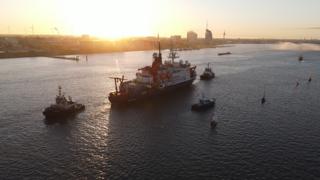World
German ship completes historic Arctic expedition

Annika Meyer
RV Polarstern returns to the port city Bremerhaven early on Monday
The German Research Vessel Polarstern has sailed back into its home port after completing a remarkable expedition to the Arctic Ocean.
The ship spent a year in the polar north, much of it with its engines turned off so it could simply drift in the sea-ice.
The point was to study the Arctic climate and how it is changing.
And expedition leader, Prof Markus Rex, returned with a warning. “The sea-ice is dying,” he said.
“The region is at risk. We were able to witness how the ice disappears and in areas where there should have been ice that was many metres thick, and even at the North Pole – that ice was gone,” the Alfred Wegener Institute scientist told a media conference in Bremerhaven on Monday.
Image copyright
Stefan Hendricks
Mid-winter in the Arctic is accompanied by 24-hour darkness
RV Polarstern was on station to document this summer’s floes shrink to their second lowest ever extent in the modern era.
The floating ice withdrew to just under 3.74 million sq km (1.44 million sq miles). The only time this minimum has been beaten in the age of satellites was 2012, when the pack ice was reduced to 3.41 million sq km.
The downward trend is about 13% per decade, averaged across the month of September.
“This reflects the warming of the Arctic,” said Prof Rex. “The ice is disappearing and if in a few decades we have an ice-free Arctic – this will have a major impact on the climate around the world.”
Image copyright
Esther Horvath
On occasions the expedition was harassed by polar bears
The €130m (£120m/$150m) cruise set off from Tromsø, Norway, on 20 September last year. The project was named the Multidisciplinary drifting Observatory for the Study of Arctic Climate (MOSAiC).
The idea was to recreate the historic voyage of Norwegian polar researcher Fridtjof Nansen, who undertook the first ice drift through the Arctic Ocean more than 125 years ago.
RV Polarstern embedded itself in the ice on the Siberian side of the Arctic basin with the intention of floating across the top of the world and emerging from the floes just east of Greenland.
In the course of this drift, hundreds of researchers came aboard to study the region’s environment.
They deployed a battery of instruments to try to understand precisely how the ocean and atmosphere are responding to the warming forced on the Arctic by the global increase in greenhouse gases.
Image copyright
MOSAIC/AWI
Investigations were conducted to improve future measurements made from space
Coronavirus only briefly interrupted the expedition – not by making participants ill, but by obliging the ship at one point to leave the floes to go pick up its next rotation of scientists. Other ships and planes were supposed to deliver the participants direct to RV Polarstern, but international movement restrictions made this extremely challenging in the early-to-middle part of this year.
Despite the hiatus, Prof Rex declared the MOSAiC project a huge success.
The mass of data and samples now in the possession of researchers would make the modelling they use to project future climate change much more robust, he explained.
It was as if the MOSAiC scientists had been shown the inner workings of an intricate clock, he said.
“We looked at all the different elements, down to the different screws of this Arctic system. And now we understand the entire clockwork better than ever before. And maybe we can rebuild this Arctic system on a computer model,” he told reporters.
Image copyright
Kerstin_Rolfes
The ship returned to a world that is very different from the one it left
Image copyright
Steffen Graupner
Prof Rex said the sea-ice was very thin or even absent in places where it used to be thick
